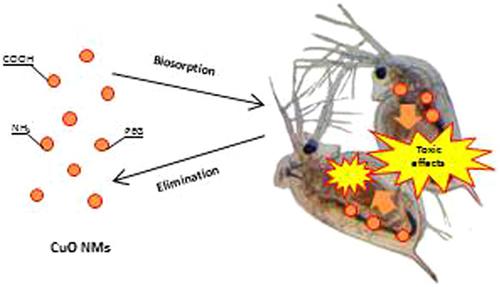当前位置:
X-MOL 学术
›
Environ. Toxicol. Chem.
›
论文详情
Our official English website, www.x-mol.net, welcomes your
feedback! (Note: you will need to create a separate account there.)
Importance of Surface Coating to Accumulation Dynamics and Acute Toxicity of Copper Nanomaterials and Dissolved Copper in Daphnia magna.
Environmental Toxicology and Chemistry ( IF 3.6 ) Pub Date : 2020-01-09 , DOI: 10.1002/etc.4617 Zuzanna Gajda-Meissner 1 , Konrad Matyja 2 , David M Brown 3 , Mark G J Hartl 1 , Teresa F Fernandes 1
Environmental Toxicology and Chemistry ( IF 3.6 ) Pub Date : 2020-01-09 , DOI: 10.1002/etc.4617 Zuzanna Gajda-Meissner 1 , Konrad Matyja 2 , David M Brown 3 , Mark G J Hartl 1 , Teresa F Fernandes 1
Affiliation

|
We evaluated the effect of copper oxide nanomaterials (CuO NMs), uncoated and with 3 different surface coatings (carboxylated, pegylated, and ammonia groups), on acute toxicity and accumulation dynamics in Daphnia magna. With the use of biodynamic modelling, biosorption and elimination rate constants were determined for D. magna following waterborne exposure to dissolved Cu and CuO NMs. The relationship between modeled parameters and acute toxicity endpoints was evaluated to investigate whether accumulation dynamics parameters could be used as a predictor of acute toxicity. The Langmuir equation was used to characterize the biosorption dynamics of Cu NMs and Cu chloride, used as dissolved Cu control. Uptake rates showed the following NM rankings: pristine-CuO > NH3 -CuO > aqueous Cu > polyethylene glycol (PEG)-CuO > COOH-CuO. To determine Cu elimination by D. magna, a one-compartment model was used. Different elimination rate constants were estimated for each chemical substance tested. Those that were easily biosorbed were also easily removed from organisms. Biosorption and depuration properties of NMs were correlated with zeta potential values and diameters of NM agglomerates in the suspensions. No link was found between biosorption and toxicity. Waterborne exposures to more difficult-to-biosorb CuO NMs were more likely to induce adverse effects than those that biosorbed easily. It is proposed that some physicochemical properties of NMs in media, including zeta potential and agglomerate diameter, can lead to higher biosorption but do not necessarily affect toxicity. The mode of interaction of the NMs with the organism seems to be complex and to depend on chemical speciation and physicochemical properties of the NMs inside an organism. Moreover, our findings highlight that coating type affects the biosorption dynamics, depuration kinetics, and dissolution rate of NMs in media. Environ Toxicol Chem 2020;39:287-299. © 2019 SETAC.
中文翻译:

表面涂层对大型蚤中铜纳米材料和溶解铜的累积动力学和急性毒性的重要性。
我们评估了未涂覆且具有3种不同表面涂层(羧化,聚乙二醇化和氨水基)的氧化铜纳米材料(CuO NMs)对大型蚤的急性毒性和累积动力学的影响。利用生物动力学模型,在水暴露于溶解的Cu和CuO NMs之后,测定了D. magna的生物吸附和消除速率常数。评估了建模参数与急性毒性终点之间的关系,以研究累积动力学参数是否可以用作急性毒性的预测指标。Langmuir方程用于表征Cu NMs和Cu氯化物的生物吸附动力学,用作溶解的Cu对照。摄取率显示以下NM等级:原始CuO> NH3 -CuO> Cu水溶液>聚乙二醇(PEG)-CuO> COOH-CuO。为了确定D. magna对铜的消除,使用了一个单室模型。对于每种测试的化学物质,估计了不同的消除速率常数。那些容易被生物吸附的物质也很容易从生物体中去除。NMs的生物吸附和净化特性与悬浮液中zeta电位值和NM附聚物的直径相关。在生物吸附和毒性之间没有发现联系。与难以生物吸附的CuO NM相比,水暴露于更难生物吸附的CuO NMs更有可能引起不利影响。有人提出,NMs在培养基中的某些物理化学性质,包括ζ电位和团聚体直径,可以导致更高的生物吸附性,但不一定会影响毒性。NM与生物的相互作用模式似乎很复杂,并且取决于生物内部NM的化学形态和理化性质。此外,我们的发现突出表明涂层类型会影响NM在介质中的生物吸附动力学,净化动力学和溶解速率。Environ Toxicol Chem 2020; 39:287-299。©2019 SETAC。
更新日期:2020-01-26
中文翻译:

表面涂层对大型蚤中铜纳米材料和溶解铜的累积动力学和急性毒性的重要性。
我们评估了未涂覆且具有3种不同表面涂层(羧化,聚乙二醇化和氨水基)的氧化铜纳米材料(CuO NMs)对大型蚤的急性毒性和累积动力学的影响。利用生物动力学模型,在水暴露于溶解的Cu和CuO NMs之后,测定了D. magna的生物吸附和消除速率常数。评估了建模参数与急性毒性终点之间的关系,以研究累积动力学参数是否可以用作急性毒性的预测指标。Langmuir方程用于表征Cu NMs和Cu氯化物的生物吸附动力学,用作溶解的Cu对照。摄取率显示以下NM等级:原始CuO> NH3 -CuO> Cu水溶液>聚乙二醇(PEG)-CuO> COOH-CuO。为了确定D. magna对铜的消除,使用了一个单室模型。对于每种测试的化学物质,估计了不同的消除速率常数。那些容易被生物吸附的物质也很容易从生物体中去除。NMs的生物吸附和净化特性与悬浮液中zeta电位值和NM附聚物的直径相关。在生物吸附和毒性之间没有发现联系。与难以生物吸附的CuO NM相比,水暴露于更难生物吸附的CuO NMs更有可能引起不利影响。有人提出,NMs在培养基中的某些物理化学性质,包括ζ电位和团聚体直径,可以导致更高的生物吸附性,但不一定会影响毒性。NM与生物的相互作用模式似乎很复杂,并且取决于生物内部NM的化学形态和理化性质。此外,我们的发现突出表明涂层类型会影响NM在介质中的生物吸附动力学,净化动力学和溶解速率。Environ Toxicol Chem 2020; 39:287-299。©2019 SETAC。











































 京公网安备 11010802027423号
京公网安备 11010802027423号